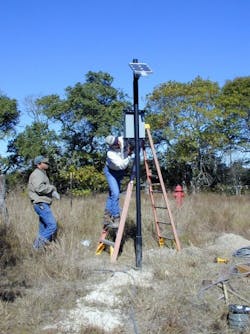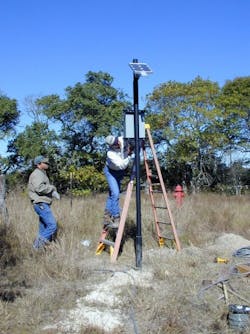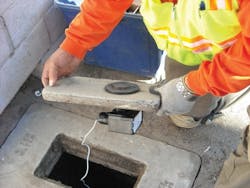By Peter Polson
Water resource managers today are charged with protecting water sources, often in isolated areas, against the threats posed by aging infrastructure, pollution and the possibility of terrorism. Increasingly, they are turning to cellular communications solutions to help them effectively manage water resources throughout the distribution process.
The Lower Colorado River Authority (LCRA), a state agency in central Texas that provides wholesale water and energy to cooperatives and communities, is one such organization that has integrated cellular data into its water monitoring solutions.
LCRA's wholesale water division was interested in testing the cost effectiveness of a wholly automated remote monitoring solution to read bulk water meter distribution points. They enlisted engineers from the agency's hydrologic services department to develop a pilot program aimed at eliminating manual data collection at remote sites.
The purpose of the meter automation project was twofold: to accurately track the volume of water delivered to each customer; and to monitor water flow in real time so that potential disruptions could be identified before they became critical.
LCRA's wholesale water customers have underground metering vaults that use mechanical registering devices to record the volume of water delivered. Without the cellular monitoring solution, an employee must travel up to an hour to each remote site to visually inspect then meters. A typical inspection requires physically entering the vault to read the meter.
To eliminate the site visits, LCRA leveraged a cellular data solution with broad coverage that can reach across its water distribution network. At critical junctions in the water network, LCRA has installed automated data loggers that dynamically track water flow. LCRA uses a cellular gateway, connected to each data logger via a serial connection, to access meter data. The data is sent to a central office to be analyzed for water flow tracking and predictive analysis to identify potential issues.
With no wireline power to most of the remote locations, LCRA relies on a small solar panel to run each site. The cellular gateway requires approximately 50mA while idle and no more than 200mA for transmissions. The data logger has similar power requirements. A power budget spreadsheet has helped LCRA calculate that a typical deployment can run reliably with a 20-watt solar panel. To ensure 24 hour monitoring, the authority uses a 20-amp battery for nighttime power.
Most water network deployments covering large geographic areas include a mix of multiple cellular carriers, enabling IT managers to ensure sufficient network coverage at every remote location. LCRA, however, was able to select one national carrier with a network large enough to provide adequate coverage. Knowing that each data logger generated logs every 15 minutes, totaling 10KB each day, they purchased a cost-effective metered data plan that met their monthly needs.
"The intelligent cellular gateways that we have deployed are incredibly reliable," said Andy Verrett, senior systems technician at LCRA. "We have had no connectivity problems to speak of. Although we experience occasional outages due to the data logger, the cellular equipment is rock solid."
Each cellular gateway is equipped with a static IP address from the cellular carrier, allowing managers and engineers in the central office to query the data logger or cellular gateway at any time for status reports or to change configuration parameters.
LCRA has not needed special cellular antennas or amplifiers to ensure reliability connectivity. However, remote locations with a weak signal that is unreliable for cell phone calls can often still provide cellular data dependably by using a higher-gain antenna or, in some cases, an inexpensive cellular amplifier. Experienced systems integrators can help customers identify the proper accessories for a particular deployment scenario.
Overall, LCRA has found the solution to be effective and dependable, with no connectivity problems to date.
The data logger, intelligent cellular gateway, battery, and solar panel are mounted on a pole with an unobstructed view of the sun in the southern sky. The logger and gateway are then secured inside a plastic enclosure built to NEMA 4 standards for protection from moisture and dust. Mounted out of reach on the pole, the enclosure is protected from vandalism. Because all of the equipment is designed to withstand broad temperature ranges, no heating or cooling systems are needed. Even on a hot Texas day, the equipment performs consistently.
Conclusion
The combined solution is a dramatic operational improvement for LCRA. Remote locations that previously required a multi-hour round trip from the office can now be monitored safely from a desk. Real time information allows managers to more effectively monitor surges in demand or problems with the water distribution network.
The challenges faced by LCRA are familiar to water managers around the country: the water management industry is dependent on accurate monitoring information to ensure a safe, reliable water supply, yet remote locations are notoriously hard to monitor. While cellular data networks were once limited in scope and reliability, today's cellular networks have advanced significantly and now offer comparable reliability to some wireline networks. As a result, many water resource managers are now dependent on cellular data solutions to better manage water supply systems while reducing operating and maintenance costs. WW
About the Author: Peter Polson leads product management for AirLink fixed gateways and routers at Sierra Wireless. Prior to Sierra Wireless, Peter was president and co-founder of Junxion Inc. which pioneered the first managed cellular router solutions. Sierra Wireless acquired Junxion in 2008.More WaterWorld Current Issue Articles
More WaterWorld Archives Issue Articles





